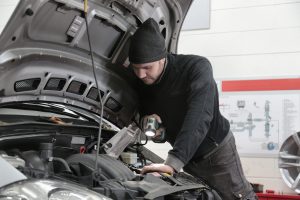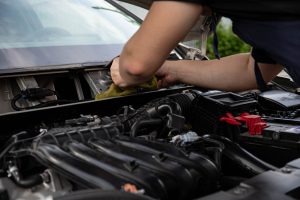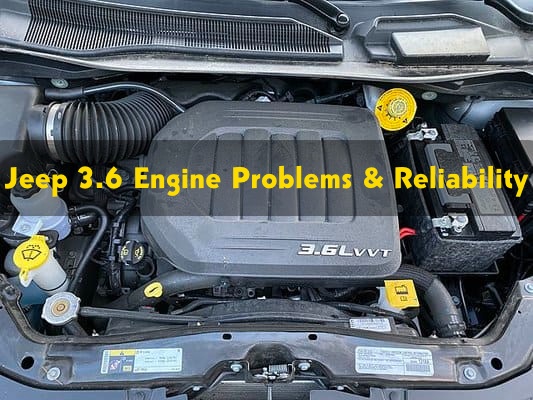Are you interested in getting a Jeep with a 3.6 engine, but you’re worried about the problems that may arise?
Generally speaking, the 3.6 engine is a relatively durable one, being capable of providing extended years of service.
Of course, proper maintenance is required, as for any other kind of engine. Keeping it well lubricated, as well as replacing old oil and filters, will prolong the life of the engine.
To find out more about the potential Jeep 3.6 Engine Problems, continue reading the following lines.
Since 2010, the 3.6 engine has been used successfully and is appreciated by Jeep, Dodge, and Chrysler car owners.
Despite the fact that it is a resilient engine, it is not perfect and may display certain problems over time.
To avoid engine issues, it is strongly recommended to respect its maintenance conditions.
Also, identifying an engine problem in an incipient stage could save the engine from severe damage and malfunctions.
Here is a list of the most frequent 3.6 Jeep engine problems a car owner could face.
If any of these occur, contact your mechanic or car shop and have the engine checked.
01. Engine Misfiring
If the engine is misfiring, most probably, the “check engine” light will appear on the car’s dashboard as well. This problem is caused, in most cases, by the failure of a cylinder head.
Such a failure occurs when the valve seats of the cylinder heat up in an excessive manner. Unfortunately, this can be considered a rather common problem of Jeep Wrangler vehicles.
An extended warranty could cover this type of problem, although the mileage and age of the car will determine whether the car is suitable or not for an extended warranty.
02. The Engine Makes a Ticking Sound
In case the engine makes a ticking sound as it runs, this may be a sign of a rocker arm failure.
Such a problem can be seen in Jeep, Dodge, and Chrysler alike, and it is also known as a cam follower failure.
Fixing this problem is not that expensive, although you may come into trouble finding an experienced mechanic who can handle the issue right.
Thus, even if the replacement part is not expensive, the labor generated by this operation might drive costs up.
03. Overheating
Are you experiencing overheating of the engine? There might be several causes behind this problem, so it is mandatory that you check it out.
If left unattended, engine overheating leads to premature wear and even irreversible damage.
Heating issues, leaks of the coolant agent, and A/C malfunctions can all be responsible for excessive heating of the engine.
The radiator or water pump may have functionality issues that keep the coolant from getting into the engine as it should.
There are situations in which engine overheating may be lit by a check engine sign on the dashboard or default code. This aspect depends on the car you’re driving.
04. Rattling or Tapping Noises
If the engine makes awkward noises, it is certainly worth it to pay attention to these noises.
In case you hear rattling, tapping, or knocking sounds then the problem the engine has may be with its oil pump.
While oil pump failures are severe and unwanted, this may not be a reason to panic. Such a problem arises when a drop in oil pressure is recorded.
Oil pressure can decrease due to a variety of reasons. Most often, it is caused by deposits of sand located behind the head of a cylinder.
Luckily, a good mechanic should be able to quickly find and solve a problem with the oil pump.
05. Clogged Pump and Radiator
The 3.6 engine is known for the fact that its radiator and pump can get clogged after a while.
This will mean a malfunction of these parts and, therefore, problems with the overall functioning of the engine.
It is worth mentioning that such situations occur not because the engine works badly but because of improper quality control of the engine before it leaves the factory.
Because the head of the engine is made out of sand cast, it is possible for debris to remain stuck in the head.
When a car runs with such an engine, the sand debris will, eventually, end up in the radiator and pump, clogging the parts.
Possible Solutions To Jeep 3.6 Engine

01. Solution of Engine Misfiring
There can be quite a few causes that lead to engine misfiring. Most often, a malfunctioning cylinder can lead to this kind of issue.
When this happens, you will feel your car stumbling on the road or lose its power for the moment. Unfortunately, there’s nothing you can do to the car on the spot.
The best solution would be to schedule an appointment with your vehicle to see if a cylinder or anything else is the culprit.
02. Solution of Engine Ticking Sound
When you hear a ticking sound made by the engine of your car, this may be due to a broken rocker arm. If the rocker’s arm is indeed the cause, it will need replacement in a car shop.
Not fixing the problem can lead to a loss in the car’s power as you drive on the road or it can even make your car not start until the rocker arm is replaced.
Buying a new rocker arm is not expensive, but you may end up paying more for the labor, as the process requires knowledge and experience.
03. Solution of Engine Overheating
Engine overheating is never a good idea. Excessive heat can damage the engine to the point that it can get damaged irreversibly.
If you notice your engine overheating, get it checked as soon as possible. Also, try not to drive the car, as this can lead to additional problems, like damage to various engine parts.
In case this happens to you away from home, check the oil levels to see if you didn’t run out of car oil.
If the oil levels are fine, you can drive the car with care, making often breaks to allow it to cool down or you can have it towed back home.
If it gets overheated fast and very severely, driving it can represent a major risk.
04. Solution of Rattling or Tapping Noises
When the engine makes various sounds, this can be due to a multitude of factors. This is why, for your peace of mind, it’s worth having the engine checked.
Since rattling or tapping noises can be due to a faulty oil pump, the first thing you can do is check the oil levels.
Make sure there’s enough oil in the car to protect the engine as you drive.
Most often, a faulty oil pump doesn’t lose oil, but pressure, which is something that can be fixed in a car shop.
05. Solution of Clogged Pump and Radiator
If the radiator and pump fail to function properly, this may be due to the fact that they get clogged.
In this case, the only solution is to have them checked and cleaned, if this is possible.
If the debris caused damage to the parts, they might require a replacement. But this can be determined only after a close inspection.
How Does 3.6 Engine Work?
The 3.6 engine is an engine made by General Motors to suit not only Jeeps but also other types of vehicles.
It is an engine with 6 cylinders and it belongs to the 3rd generation of V6 engines made by GM.
The production code of this engine is LFX and it comes after the previous generation LGX. It was designed to be lighter yet more powerful than its predecessors.
The more modern and lighter-weighted components used for its making improve the engine’s performance, resilience to wear and tear, and overall effectiveness.
Highlighted Features of Jeep 3.6 Engine

Some of the most important features of a Jeep 3.6 engine are:
- Connecting rods made out of forged steel;
- The die-cast aluminum block, high-pressure resilient, which features a V-shape angle of 60 degrees;
- Pistons are made out of cast aluminum alloy;
- Each cylinder features four valves;
- Chain-driven camshaft;
- Crankshaft made out of nodular iron;
- Four-hole injectors are responsible for the port injection;
- The compression rate of the engine is 10:2:1;
- A mold cylinder head that is made out of T7 aluminum;
Advantages of 3.6 Engine
- A resilient engine that can have a lifespan of 250-300k miles, with proper maintenance
- With the right care, it can run for miles without any trouble
- A powerful engine you can always rely on, with horsepower ranging between 260 and 293 based on model and year
- The gas mileage is great, considering the power of the engine
Disadvantages of 3.6 Engine
- Premature wear and overheating of the engine
- The cooling system may also fail, rather easily, as many Jeep 3.6 engine owners complain about it
- A rocker arm failure is also quite common among Jeeps with this type of engine
- Most failures occur in the water pump and radiator
2013 Jeep Wrangler 3.6 Engine Problems
- Cylinder heads may be faulty, with the cylinder being the one that fails in most cases. When this happens, the engine gets noisy, the “check engine” light appears on the dashboard, and the car misfires
- The radiator unit, water pump, and oil cooler are malfunctioning. The problem is, most often, caused by sand residues coming from the cylinder heads
- Oil pumps are known to be faulty in Jeep Wrangler cars with this engine. This results in bad oil flow and a car with poor performance
- Failure of rocker’s arms, although this type of problem was not that common. The car needs a functioning rocker arm for proper combustion
2012 Jeep Wrangler 3.6 Engine Problems
- The car’s computer may crash or display a variety of failures. In fact, computer failures in a 2012 Jeep Wrangler are quite common once the car hits 50,000 miles. And there is one single solution and that would be the replacement of the computer
- Cylinder head problems may also arise around 50,000 miles or sooner. Cylinder head replacement can quickly fix this, although the issue with this is the high costs that come along with the repair
- Issues of the heater system seem to happen even sooner, at around 35,00 miles, as Jeep owners complain. Because the heater’s core wears down this quickly, a replacement is the only solution
Jeep and Grand Cherokee 3.6 Engine Problems
- Engine stalling while driving the car on the road is a rather often problem of the 3.6 engine, regardless if we are talking about Jeep, Grand Cherokee, or Chrysler. The valves are often the case, but it is worth checking the problem out
- Failure of the alternator is also a problem that arises in many Jeeps and Grand Cherokees. When this happens, the battery of the car fails to charge as the engine is running. Thus, issues will appear (including the impossibility of driving the car) due to the lack of electrical power
- Erratic electronic shifting can also occur and it sounds worse than it actually is. Worn parts in the transmission of the car or a bad sensor can lead to this problem, which can be solved by an experienced mechanic
Photo Credit; wikimedia.org, C.C
Related Shifting: Jeep Wrangler Automatic Transmission Shifting Problems
People Also Ask For
Is The 3.6 Engine a Good Engine For a Jeep?

Despite the fact that it may have some issues, the 3.6 engine is one of the most reliable engines for Jeeps. It is highly durable and capable of incredible performance.
There’s a very good reason why this engine continues to be used since 2010, not only to equip generations of Jeeps but also Dodge and Chrysler. So, it may be one of the best engines ever built for Jeeps.
How Many Miles Can a Jeep 3.6 Engine Last?
The Jeep 3.6 engine can run up to 300,000 miles or more without major repairs, but only if it is properly maintained.
Oils and filters need to be changed periodically, as indicated, to prolong the life of the engine.
Find a trustworthy mechanic who knows Jeep engines well, and go for periodic inspections, making sure everything runs as it should.
Jeeps Made in Which Years Should Be Avoided?
If there are any Jeep Wrangler cars you should avoid, then they should be those made between 2007 and 2008 and 2012 and 2014.
The cars made in these years have interiors that don’t look that great. Their engines are underpowered and may cost a lot to fix once problems occur.
Which is The Most Reliable Engine For Jeep?
On the list of most reliable engines for Jeeps, the 3.6L Pentastar Jeep 3.6 Engine Problems V6 certainly occupies a top position.
It is a great option for Jeep enthusiasts, offering power, reliability, and resistance over the years.
Also, newer generations of the 3.6 engine are even better, as they have become more effective when it comes to fuel consumption while delivering improved performances.
Final Thoughts
While it is true that there are problems with the 3.6 engine used in Jeeps and other car makes, this still remains a reliable engine.
With proper maintenance, a 3.6 engine can run without problems for miles in a row. It has the power needed to deal with any kind of terrain and runs nicely on motorways as well.
Find out more about the Jeep engine; https://www.motortrend.com/features/jeep-wrangler-jl-engine-differences/

Hello there, this is Thomas Byrd. I am a professional car mechanic who leads a team of junior mechanics in a repair and restoration shop. In the beginning, I used to work for a jeep service center as a basic worker. From there I keep learning, changed my job 2 times and now I am a professional who leads a group of mechanics. Though a have expertise in the jeep, I know very well about all types of cars. To share my knowledge and skills with others I have created this blog website. Whenever I get free time from work I give my time to my blog.

